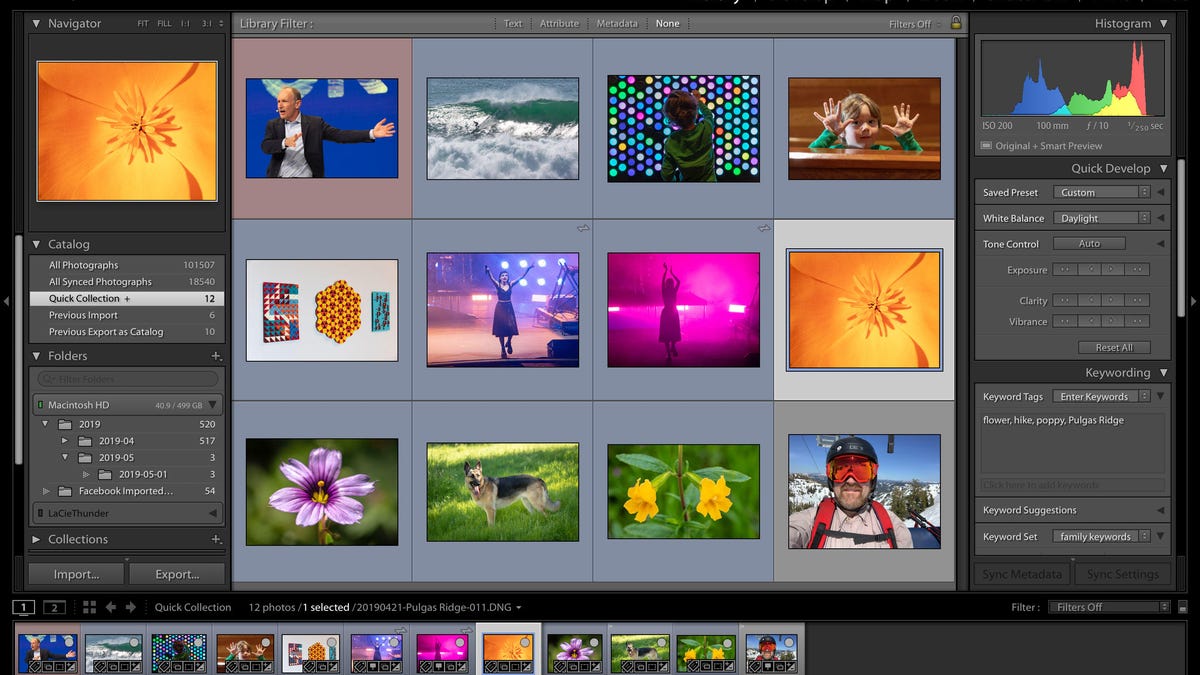Adobe promises faster Lightroom photo editing thanks to GPU chip
PC graphics processors are being put to new use in the latest release of Lightroom Classic.

Lightroom Classic lets photographers edit and catalog photos.
Adobe's Lightroom, long dogged by complaints it's grown sluggish at editing and organizing photos, got a performance boost Tuesday by tapping into the processing power of the graphics chip in Windows and Mac computers.
The August release of Lightroom Classic should speed up editing and make the software more responsive in general, said Josh Haftel, principal product manager at Adobe, in a blog post. The benefits will be more pronounced on high-resolution monitors and with fast graphics chips, he said, but didn't quantify the improvement.
Lightroom can handle common photo formats like JPEG, but it's best suited for people who tap into higher-end cameras' ability to shoot in raw photo formats. Those preserve more details, color and dynamic range, but require you to put in some work making them into a presentable, shareable form. And it's a lot of work for computers to handle those raw photos, too, so performance boosts are crucial.
Lightroom had used the GPU earlier, so what's new this time? Here's what Haftel told me:
The most recent improvements to GPU acceleration are targeted at improving the performance while editing. That means the improvements will be seen while moving the editing sliders. We're working on improving the GPU acceleration for rendering images, such as on export. No timeline can be shared at this time.
He also said Adobe is working to bring more GPU acceleration to other versions of Lightroom besides Classic. For details on using it, check Adobe's instructions on enabling Lightroom GPU acceleration.
Adobe has several Lightroom incarnations: the full-featured Lightroom Classic, which is the renamed version of the original software for Macs and Windows machines; Lightroom, which also works on PCs, relies on cloud-based photo storage and lacks some Classic features; the related Lightroom for the web; and mobile versions for Android and iOS phones and tablets. The mobile versions are free but lack some premium features that you can get if you sign up for a Lightroom subscription -- $10 per month and up.
The new Lightroom releases have a number of other changes, too:
- New search tools on iOS, Android and ChromeOS mean you can filter by parameters including lens focal length, the presence of a 3D depth map or images with high dynamic range (HDR), which is a greater span of bright and dark data.
- If you're adding metadata like copyrights and titles to Lightroom on Android and Chrome OS, you can now apply it to groups of photos.
- If you group multiple photos into stacks, you can now set Lightroom Classic to turning those stacks into HDR images or panoramas en masse with a new batch feature.
- For the cloud-based Lightroom versions, you can now retrieve deleted files for up to 60 days.
- Lightroom Classic now lets you label collections with colors.
- If you like an effect you see in Adobe's new discover section, which shows tutorials on how people edit their photos, you can turn that into a preset you can reuse on your own photos.
- All the versions also support some new cameras' raw photo formats and some new lenses, including Canon's most recent RF models for its full-frame mirrorless camera.
First published August 13, 7:48 a.m. PT
Update, 12:30 p.m. PT: Adds detail about GPU acceleration.

